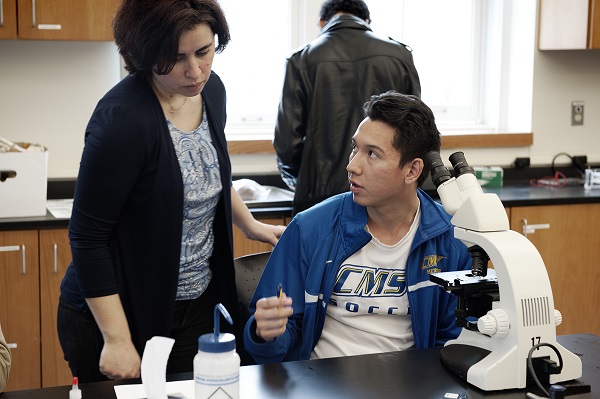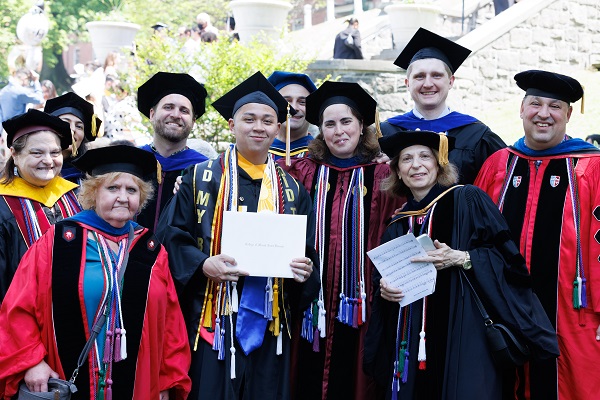Making Noise About Gene Silencing
12/16/2022
Faculty Spotlight: Dr. Ribeiro’s Research Gives a New Definition to “Good Genes”

Professor of Biology Ana Ribeiro, Ph.D. uses an unusual but relatable metaphor to help explain to a non-scientific listener the laboratory technique known as gene silencing:
“Imagine the brain is a classroom filled with red and blue chairs. You want to investigate the effect of red chairs, so you suppress the blue chairs, which allows you to study the expression of the remaining red chairs and their effect on the brain.”
Makes sense—right?
In her scholarly research, Dr. Ribeiro has studied and applied methods of gene silencing, which is the temporary blocking of a specific gene that normally triggers a certain effect—an emerging area of research technology that has the potential to provide targeted treatments for genetic diseases.
Her expertise in this very precise scientific practice has led her to publish or present several papers in which she uses the technique. Most recently, she authored a chapter in a book aimed at guiding laboratory research teams in performing the technique. That book, Estrogen Receptors: Methods and Protocols, was published earlier this year by Springer. In the chapter, “Immunofluorescent Verification of Silencing Estrogen Receptor α with siRNA in the Intact Rodent Brain,” she and her colleagues described how to perform gene silencing and how to check its efficacy afterward—or, using her clever metaphor, “making sure all the blue chairs are still gone.”
The book is part of a well-known and respected series known as Methods in Molecular Biology. Each book is meant to serve as a detailed, helpful resource for laboratory professionals, with each volume tailored toward a specific area of scientific research. Like the recipes in a cookbook, each individual chapter spells out the “recipe” for techniques and protocols that make up the painstaking work in a research lab, and includes lists of materials, orders of operations, troubleshooting guides, and tips for success.
“Our chapter outlines a technique for silencing gene expression that my team and I have mastered,” said Dr. Ribeiro. “A lab might use the technique for any number of experiments, from the organs to the study of social behavior. They can also apply it to any gene, not just receptor-mediated actions of estrogen, the topic of this book.”
A growing arm of research is uncovering new information about the role of estrogen in human and animal behavior. A landmark 1996 study by Ribeiro and her colleagues found that suppressing the estrogen receptor alpha gene in the brains of female mice can interrupt a signal that prompts the mice to care for their young. “Silencing this gene in female mice removes their interest in nurturing or protecting their babies,” said Dr. Ribeiro. By using this highly efficient protocol for suppressing what came to be known as “the mommy gene,” researchers were able to investigate this phenomenon more fully.
“My colleagues and I had previously published articles describing maternal behavior in mice. During the course of our research, we had developed the protocol for suppressing gene suppression in a very localized brain region. When it came to the attention of the book’s editor, she invited us to contribute a chapter describing the technique,” said Dr. Ribeiro.

Dr. Ribeiro has devoted many years to the study of hormonal regulation of behavior and its many manifestations, including sleep mechanisms and hormone biology. After earning her Ph.D. from Fordham University, she completed her post-doctoral study at the famed Rockefeller Institute, and the lab she joined was the first to identify estrogen receptors in the brain.
She points out that, historically, most research is conducted on male subjects, both animal and human. “Because females have fluctuating hormones, the ability to understand behavior becomes more complicated,” she said. “I’m interested in these underlying hormonal changes, which can affect not just mood but also productivity, energy level, physical performance, and sleep cycles. In fact, almost everything we do is superimposed on the hormonal cycle.”
During this past year, Dr. Ribeiro has also seen her work published in the prestigious Proceedings of the National Academy of Sciences (PNAS). The neuroscience article, “Temporal relations between peripheral and central arousals in good and poor sleepers,” explores how arousals represent a fundamental property of the nervous system that enables organisms to perceive and properly respond to internal and external challenges. Among the questions that have remained elusive? When and how central and peripheral arousals are coordinated or integrated. Poor sleepers exhibit a heightened arousal phenotype, and the communication between central and peripheral arousal mechanisms is inherently different from that of good sleepers—so, though the etiology of insomnia remains poorly understood, screening for peripheral arousal events prove to be a valuable tool in the assessment and diagnosis of poor sleeping.
Since her arrival at the Mount in 2009, Dr. Ribeiro has taught general biology as well as specialty courses such as neurobiology and systemic physiology. Many of her students are working toward careers in medicine or physical and occupational therapy. In the classroom, she usually begins by telling students, “I don’t want you to memorize. I want you to think.” By encouraging her students to use their common sense when approaching a scientific problem, she fosters the critical thinking skills they will use in every aspect of their lives.
Dr. Ribeiro enjoys challenging students to read scientific articles while asking themselves, “How would I test that theory?” In the internship class she teaches, students return from their placements at care facilities and medical offices eager to share their observations. “I encourage them to ask questions of the medical teams, such as: ‘Have we tried this? Would such and such a treatment be useful for this patient?’ I want them to be engaged and active in their placements, not just observing and memorizing.”
The walls of Ribeiro’s office are covered with photographs of her former students, often taken on graduation day. Many come to her at the end of their senior year, wanting to thank her for all they learned in her classes by giving her a gift. “I refuse all gifts except the photos. I tell them, ‘The only gift I’ll ever need is a picture of you, doing well.’ Their success gives me great happiness.”

About the University of Mount Saint Vincent
Founded in 1847 by the Sisters of Charity, the University of Mount Saint Vincent offers nationally recognized liberal arts education and a select array of professional fields of study on a landmark campus overlooking the Hudson River. Committed to the education of the whole person, and enriched by the unparalleled cultural, educational and career opportunities of New York City, the College equips students with the knowledge, skills and experiences necessary for lives of achievement, professional accomplishment and leadership in the 21st century.
